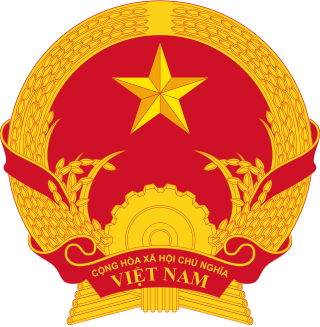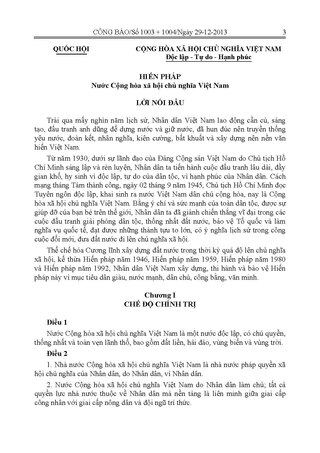
The Supreme Soviet of the Union of Soviet Socialist Republics was, from 1936 to 1991, the highest body of state authority of the Union of Soviet Socialist Republics (USSR), and based on the principle of unified power was the only branch of government in the Soviet state.

The politics of Vietnam is dominated by a single party under an authoritarian system, the Communist Party of Vietnam (CPV). The President of Vietnam is the head of state, and the Prime Minister of Vietnam is the head of government, both of these are separate from the General Secretary of the Communist Party of Vietnam who leads the CPV and is head of the Politburo and the Central Military Commission, thus the General Secretary is the de facto supreme leader of Vietnam. Executive power is exercised by the government and the President of Vietnam. Legislative power is vested in the National Assembly of Vietnam. The Judiciary is independent of the executive. The parliament adopted the current Constitution of Vietnam, its fifth, on 28 November 2013.

The Constitution of the People's Republic of China is the supreme law of the People's Republic of China. It was adopted by the 5th National People's Congress on December 4, 1982, with further revisions about every five years. It is the fourth constitution in PRC history, superseding the 1954 constitution, the 1975 constitution, and the 1978 constitution.

The National Assembly was the authoritative legislative body of the Republic of China, from 1947 to 2005. Along with the Control Yuan and the Legislative Yuan, the National Assembly formed the tricameral parliament of the Republic of China.

A communist state, also known as a Marxist–Leninist state, is a one-party state that is administered and governed by a communist party guided by Marxism–Leninism. Marxism–Leninism was the state ideology of the Soviet Union, the Comintern after Bolshevisation and the communist states within the Comecon, the Eastern Bloc, and the Warsaw Pact. Marxism–Leninism currently still remains the ideology of a few parties around the world. After its peak when many communist states were established, the Revolutions of 1989 brought down most of the communist states; however, it is still the official ideology of the ruling parties of China, Cuba, Laos, Vietnam, and to a lesser extent, North Korea. During the later part of the 20th century, before the Revolutions of 1989, around one-third of the world's population lived in communist states.
The 1977 Constitution of the Soviet Union, officially the Constitution of the Union of Soviet Socialist Republics, was the constitution of the Soviet Union adopted on 7 October 1977.

The president of the Socialist Republic of Vietnam is the head of state of Vietnam, elected by the National Assembly of Vietnam from its delegates. Since Vietnam is a one-party state, candidates for the post are nominated by the Central Committee of the Communist Party of Vietnam. The officeholder is generally considered to hold the second-highest position in the political system, practically after the General Secretary of the Communist Party of Vietnam.
The Congress of Soviets was the supreme governing body of the Russian Soviet Federative Socialist Republic and several other Soviet republics from 1917 to 1936 and a somewhat similar Congress of People's Deputies from 1989 to 1991. After the creation of the Soviet Union, the Congress of Soviets of the Soviet Union functioned as its legislative branch until its dissolution in 1936. Its initial full name was the "Congress of Soviets of Workers', Soldiers' and Peasants' Deputies". It was also sometimes known as the "Congress of People's Deputies." A similar name also applied in communist-held China in the Republican era.

The Vietnamese Constitution or the Constitution of Vietnam, fully the Constitution of the Socialist Republic of Vietnam, is the fundamental and supreme law of the Socialist Republic of Vietnam. The current constitution was adopted on November 28, 2013, by the Thirteenth National Assembly and took effect on January 1, 2014, being the third constitution adopted by the Vietnamese state since the political reunification of the country in 1976.

The political system of the Soviet Union took place in a federal single-party soviet socialist republic framework which was characterized by the superior role of the Communist Party of the Soviet Union (CPSU), the only party permitted by the Constitution.

The Great National Assembly was the supreme body of state power of the Socialist Republic of Romania. The Great National Assembly was the only branch of government in Romania, and per the principle of unified power, all state organs were subservient to it. After the overthrow of Communism in Romania in December 1989, the Great National Assembly was dissolved by decree of the National Salvation Front (FSN) and eventually replaced by the bicameral parliament, made up of the Chamber of Deputies and the Senate.
The Constitutional history of the People's Republic of China describes the evolution of its Constitutional system. The first Constitution of the People's Republic of China was promulgated in 1954. After two intervening versions enacted in 1975 and 1978, the current Constitution was promulgated in 1982. There were significant differences between each of these versions, and the 1982 Constitution has subsequently been amended several times. In addition, changing Constitutional conventions have led to significant changes in the structure of the Chinese government in the absence of changes in the text of the Constitution.

The Supreme Soviet of the Russian SFSR, later Supreme Soviet of the Russian Federation, was the supreme government institution of the Russian SFSR in 1938–1990; in 1990–1993 it was a permanent legislature (parliament), elected by the Congress of People's Deputies of the Russian Federation.
The 1953 Yugoslav Constitutional Law was a big packet of constitutional amendments to the 1946 Yugoslav Constitution, with the goal of introducing the idea of self-management in the constitutional matter of the Federal People's Republic of Yugoslavia. It came into effect on January 13, 1953. The amended 1946 constitution would remain in power until the adoption of the 1963 Yugoslav Constitution.
The central committee is designated as the highest organ of a communist party between congresses. Per the principles of democratic centralism and unified power, the central committee is empowered to deal with any issue that falls under the party's purview. While formally retaining this role in socialist states, commonly referred to as communist states by outside observers, in practice, it delegates this authority to numerous smaller internal organs due to the infrequency of its meetings. The term of a central committee of a ruling communist party is usually five years. The party congress elects individuals to the central committee and holds it accountable. At the first central committee session held immediately after a congress, it elects the party leader, an office usually titled general secretary of the central committee, a political organ, commonly known as the politburo, and a executive organ, customarily named the secretariat.

The All-Russian Congress of Soviets evolved from 1917 to become the supreme governing body of the Russian Soviet Federative Socialist Republic from 1918 until 1936, effectively. The 1918 Constitution of the Russian SFSR mandated that Congress shall convene at least twice a year, with the duties of defining the principles of the Soviet Constitution and ratifying peace treaties. The October Revolution ousted the provisional government of 1917, making the Congress of Soviets the sole, and supreme governing body. This Congress was not the same as the Congress of Soviets of the Soviet Union which governed the whole Soviet Union after its creation in 1922.
The Ukrainian Soviet Socialist Republic, part of the Soviet Union, had four successive constitutions during its existence. The first (1919) was in Russian and the final three were in Ukrainian.

Democratic centralism is the organisational principle of communist states and of most communist parties to reach dictatorship of the proletariat. In practice, democratic centralism means that political decisions reached by voting processes are binding upon all members of the political party. It is mainly associated with Leninism, wherein the party's political vanguard of revolutionaries practice democratic centralism to select leaders and officers, determine policy, and execute it.












